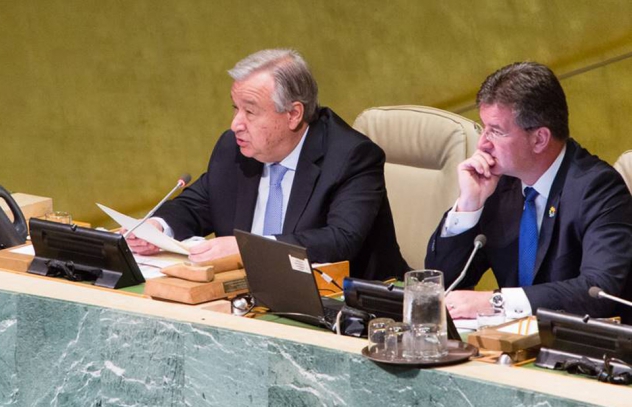2016年6月の国連ハイレベル会合で採択された『エイズ終結に関する2016年国連政治宣言』では、その後の世界のHIV/エイズ対策について、国連事務総長が毎年、総会に報告するよう求めています。その2018年版報告書『エイズ対策を国連改革とグローバルヘルスのテコに』が6月13日の総会会合で提出されました。今年は2016年の宣言採択から当面の目標である2020年までの高速対応に至る中間年ということになります。成果はそれなりに上がっているが、これからよほど頑張らなければ目標に到達することはできないといった内容です。
会合の模様を含め国連合同エイズ計画(UNAIDS)がプレス声明を発表しています。その日本語仮訳です。
報告書のタイトルをもう一度、見ていただきましょう。『エイズ対策を国連改革とグローバルヘルスのテコに』となっています。英文では Leveraging the AIDS responseです。総会議長も開会の辞で「本日の議論は他の目標や目的にもつながることを忘れてはならない」と述べています。まあ、その通りではあるのだけれど、「大切だ」と言葉の上で強調はしていても、その言葉の背景には、他の課題解決の役にも立つし・・・といったニュアンスが含まれているような感じもします。
もちろん、プレス声明を読む範囲でも、重要な指摘はたくさんあり、国連並びに加盟各国の本気度を疑うわけではみじんもありません。疑っちゃあ、いけませんよね。でも、どこか「HIV/エイズ対策はそれなりに成果を上げてきたし、ほどほどに対応していけばいいんじゃないの」といった気分が国際的にも広がっているような感じがしないこともありません。
声明の最後に載っている推計値は昨年末時点で公表されたものと同じです。新たな推計は今月末か7月初めに出されるのではないかと思います。

エイズ終結に向けた進捗状況検証の総会会合で、国連事務総長がHIV報告書を提出 UNAIDSプレス声明
ニューヨーク2018年6月13日 2016年の国連総会で合意された2020高速対応ターゲットの中間地点に際し、国連加盟国がHIV対応の検証会合に集まった。会合は米・ニューヨークの国連本部で開かれ、加盟各国がそれぞれの成果と課題を伝えるとともに(アントニオ・グテレス)国連事務総長から世界のHIV/エイズ対策の現状に関する報告を受けた。
ミロスラフ・ライチャーク国連総会議長は開会にあたり「本日の議論は他の目標や目的にもつながることを忘れてはならない」と開会の辞を述べた。「この会合はさらに広範な活動を展開していく機会としても活用することができる。このウイルスとの闘い、そしてそれに伴うスティグマとの闘いを続けていきましょう」
国連事務総長は報告書『エイズ対策を国連改革とグローバルヘルスのテコに』を提出し、「世界は2030年のエイズ流行終結に向けて大きな成果をあげています。しかし、その成果はまだ不均衡なものであり、もろくもあります。この節目の時にあたり、エイズから解放された世界の実現に向け、お互いの約束を果たす意思をもう一度しっかりと固めなければなりません」と述べた。
報告書は抗レトロウイルス治療の指数関数的な拡大により、現在では世界のHIV陽性者の半数以上が治療を受けられるようになったこと、その結果として2010年に150万人だったエイズ関連の死者数が、2016年には3分の1減の100万人に減ったことを示している。また、子供の新規HIV感染防止の成果も指摘し、世界が今後も努力を続けばHIV母子感染をなくすことが可能になると強調している。
UNAIDSのミシェル・シディベ事務局長は全体会合に出席し「私たちはエイズ終結に向けた重要な転換点に達しています。HIV感染の永続的減少に向け、結束して取り組むことがいまこそ大切です」と述べた。
会合では30カ国以上が自国の進展について報告した。その多くがUNAIDSとその合同プログラムへの評価と支援を確認するとともに、エイズ終結に関する2016年国連政治宣言で約束したターゲット実現への意思を繰り返し表明した。
「米国はHIV/エイズ・パンデミックとの闘いにおけるUNAIDSのリーダーシップを強く支持する」と米国のデボラ・バークス世界エイズ調整官兼グローバルヘルス外交特別代表は語った。「UNAIDSがHIVの疫学データを集中的に収集する努力を続け、活用できるようにしていることは、極めて重要な対策の基盤であり、このパンデミックを制御するためのロードマップを提供しています。正確なデータに基づいて、これまでの実績を把握し、対応できていないニーズを特定し、最大の成果があげられるよう効率的かつ効果的に資金を投入していかなければ、2030年のエイズ流行終結というターゲットを実現することはできません」
国連事務総長報告は、医療のアクセスを得られている人の数は2010年の770万人から2017年6月の2090万人へと3倍近く拡大している。その一方で残る1580万人はいまも必要な治療を受けられずにいるという現実もある。とりわけ子供に対する治療アクセスの拡大は遅れ、2016年段階で治療アクセスを得ているHIV陽性の子供は43%にとどまっている。
報告書はまた、新規HIV感染の防止も十分ではないことを警告している。年間の新規HIV感染者数は2010年の220万人から2016年の180万人へと18%減っている。ただし、2020年までに年間新規感染者数を50万人に抑えるというターゲットに到達するには、HIV予防の努力を大きく飛躍させなければならない。とりわけ高いリスクに曝されている人口集団への対応が必要である。全体会議の場では数多くの登壇者からこうした見解が何度も示された。
ケニアのラザラス・O・アマヨ国連大使はアフリカグループを代表して「エイズの影響は依然、サハラ以南のアフリカ地域で不均衡なまでに大きく、東部・南部アフリカ地域では若い女性の新規HIV感染のリスクがとりわけ高い状態が続いています」と語った。「HIVとエイズに対する包括的かつ普遍的で、統合されたアプローチが必要であり、そのための投資が必要なことも繰り返し強調したい」。東部・南部アフリカでは、全人口の10%にあたる15~24歳の若い女性層が、新規HIV感染の26%を占めている。
エイズ対策に必要な資金が年間70億ドルも不足していることを含め、エイズ終結に関する2016年国連政治宣言のターゲットを実現するには、なすべきことがまだ数多くあると報告書は指摘している。そして、各国が高速対応軌道に戻るために、HIV予防革命の活用、人権尊重とジェンダー平等の促進、新規感染減少のためのHIV2020ロードマップの活用など、5つの強い勧告を行っている。
2016年推計(治療普及は2017年6月現在)
・抗レトロウイルス治療へのアクセス 2090万人 [1840万–2170万人](2017年6月)
・世界のHIV陽性者数 3670万人 [308万–4290万人]
・年間新規HIV感染者数 180万人 [160万–210万人]
・エイズ関連の疾病による年間死者数 100万人 [83万–120万人]
United Nations Member States stress that critical efforts must be scaled up to end AIDS
Press statement
United Nations Secretary-General presents his report on HIV as United Nations General Assembly meets to review progress towards ending AIDS
NEW YORK/GENEVA, 13 June 2018—At the halfway point to the 2020 Fast-Track Targets agreed by the United Nations General Assembly in 2016, United Nations Member States have come together to review progress in responding to HIV. Gathered at the United Nations Headquarters in New York, United States of America, Member States presented the progress and challenges in their countries and heard from the United Nations Secretary-General, who presented his report on the global response to HIV.
The President of the General Assembly Miroslav Lajčák opened the meeting. “We cannot forget that what we are doing today ties into our other goals and objectives,” he said. “We can use today’s meeting to explore opportunities for even more action. Let’s keep going. Let’s keep fighting this virus—and the stigma that comes with it.”
The United Nations Secretary-General presented his report, Leveraging the AIDS response for United Nations reform and global health, and said, “The world is making good progress towards ending the AIDS epidemic by 2030, but progress is uneven and fragile. At this pivotal moment, we must renew our focus and shared commitment to a world free of AIDS.”
The report shows that the exponential scale-up of antiretroviral therapy has now reached more than half of all people living with HIV, which in turn has contributed to a decline of one third in AIDS-related deaths, from 1.5 million in 2010 to 1 million in 2016. It also notes the progress in stopping new HIV infections among children and highlights that eliminating mother-to-child transmission of HIV is possible if the world remains focused.
The Executive Director of UNAIDS, Michel Sidibé, attended the plenary meeting. He said, “We are at a critical juncture on the path towards ending AIDS. We must unite and use our collective force to push HIV into permanent decline.”
More than 30 Member States reported on progress in their countries, many expressing their appreciation and support for the work of UNAIDS and the Joint Programme while reiterating their commitment to achieving the targets in the 2016 United Nations Political Declaration on Ending AIDS.
“The United States strongly supports UNAIDS and its leadership in combatting the HIV/AIDS pandemic,” said Deborah Birx, United States Global AIDS Coordinator and Special Representative for Global Health Diplomacy. “UNAIDS’ focus on producing the most extensive data collection on HIV epidemiology continues to be fundamentally important and is our road map to controlling this pandemic. We cannot achieve the targets to end the AIDS epidemic by 2030 without the right data to track our progress, pinpoint our unmet need and effectively and efficiently direct resources for maximum impact.”
The report of the United Nations Secretary-General shows that while the number of people accessing treatment almost tripled from 2010 to June 2017, from 7.7 million people on treatment to 20.9 million, 15.8 million people are still in need of treatment, and progress in expanding access to treatment for children is particularly slow. Just 43% of children living with HIV had access to treatment in 2016.
It also flags that more needs to be done to stop new HIV infections. New HIV infections declined by 18% from 2010 to 2016, from 2.2 million to 1.8 million, but to reach the target of 500 000 new infections by 2020 HIV prevention efforts must be significantly stepped up, particularly among populations at higher risk, a sentiment echoed by many of the speakers at the plenary meeting.
Lazarus O. Amayo, Permanent Representative of Kenya to the United Nations, spoke on behalf of the African Group. “A lot remains to be done as AIDS continues to disproportionately affect sub-Saharan Africa, with the risk of new HIV infections remaining exceptionally high among young women in eastern and southern Africa,” he said. “We reiterate the need for a comprehensive, universal and integrated approach to HIV and AIDS, as well as investments towards it.” In eastern and southern Africa, young women aged between 15 and 24 years account for 26% of new HIV infections, despite making up just 10% of the population.
The report shows there is still much work to do to reach the targets in the 2016 United Nations Political Declaration on Ending AIDS, including filling the US$ 7 billion shortfall in funding for the AIDS response. It sets out five strong recommendations to get countries on track, including mobilizing an HIV testing revolution, safeguarding human rights and promoting gender equality and using the HIV Prevention 2020 Road Map to accelerate reductions in new HIV infections.
In 2016 (*June 2017) an estimated:
*20.9 million [18.4 million–21.7 million] people were accessing antiretroviral therapy (in June 2017)
36.7 million [30.8 million–42.9 million] people globally were living with HIV
1.8 million [1.6 million–2.1 million] people became newly infected with HIV
1.0 million [830 000–1.2 million] people died from AIDS-related illnesses